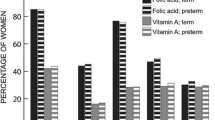Abstract
Objective: Daily consumption of supplements containing 400 μg of folic acid in the periconception period may reduce the risk of neural tube defects (NTDs) by as much as 70%. However, despite explicit recommendations, folic acid consumption among women likely to become pregnant remains low. The objectives of this study were: to evaluate women’s knowledge and beliefs with regard to folic acid; to estimate the frequency of vitamin supplement consumption; and to identify its determinants during the periconception period.
Methods: In 1999–2000, a questionnaire was completed by 1,240 pregnant women in 10 Quebec hospitals.
Results: Seventy percent of the respondents were aware of the preventive role of folic acid but only 25% had taken the recommended dose of supplements during the periconception period. Supplement consumption is associated with the pregnancy planning intensity score (OR: 1.06; 95% CI: 1.02–1.11), knowledge score (OR: 1.11; 95% CI: 1.07–1.16) and belief in the usefulness of supplements (OR: 1.56; 95% CI: 1.02–2.39).
Conclusion: These results indicate that further efforts are needed to inform the population and promote the optimal use of folic acid supplements.
Résumé
Objectifs: La consommation journalière de suppléments contenant 400μg d’acide folique en période périconceptionnelle peut diminuer jusqu’à 70 % le risque d’anomalies de fermeture du tube neural (AFTN). Malgré des recommandations explicites, le niveau de consommation chez les femmes susceptibles de devenir enceintes demeure faible. Les objectifs de cette étude étaient d’évaluer les connaissances et les croyances des femmes en regard de l’acide folique ainsi que d’estimer leur fréquence de consommation de suppléments vitaminiques puis d’identifier les déterminants de cette consommation durant la période périconceptionnelle.
Méthode: En 1999–2000, lors d’une enquête, nous avons interrogé 1 240 femmes enceintes dans 10 hôpitaux du Québec.
Résultats: Soixante-dix pourcent des participantes connaissaient le rôle préventif de l’acide folique, mais seulement 25 % avaient pris des suppléments, à la dose recommandée, durant la période périconceptionnelle. La consommation de suppléments est associée au score d’intensité de la planification de la grossesse (OR: 1,06; 95 % IC: 1,02 à 1,11), au score de connaissances (OR: 1,11; 95 % IC: 1,07 à 1,16) et à la croyance en l’utilité des suppléments (OR: 1,56; 95% IC: 1,02 à 2,39).
Conclusion: Ces résultats indiquent que des efforts sont encore nécessaires pour informer la population et promouvoir l’utilisation optimale des suppléments d’acide folique.
Similar content being viewed by others
References
Chambers K, Popkin J, Arnold W, Irwin B, Hall JG. Neural tube defects in British Columbia? Lancet 1994;343(8895):489–90.
De Wals P, Trochet C, Pinsonneault L. Prevalence of neural tube defects in the province of Quebec, 1992. Can J Public Health 1997;90(4):237–39.
Crane JMG, Sun C, Hutchens D, Crowley M. The epidemiology of neural tube defects in Newfoundland and Labrador. J Soc Obstet Gynecol Can 2001;23:510–14.
Moore, KL. L’être humain en développement. Embryologie orientée vers la clinique. Toronto: N.B. Saunders Company, 1974.
Botto LD, Moore CA, Khoury MJ, Erickson JD. Neural tube defects. Medical Progress 1999;341(20):1509–19.
McCourt C. Primary prevention of neural tube defects (issued by the HPB). CMAJ 1993;148(9):1451.
SOGC Genetics Committee. Folic acid for the prevention of neural tube defects. Pediatrics 1993;92(3):493–94.
Canadian Task Force. Periodic Health Examination, 1994 update: 3. Primary and secondary prevention of neural tube defects. CMAJ 1994;151(2):159–66.
Lewis CJ, Crane NT, Wilson DB, Yetley EA. Estimated folate intakes: Data updated to reflect food fortification, increased bioavailability, and dietary supplement use. Am J Clin Nutr 1999;70:198–207.
Raats M, Thorpe L, Hurren C, Elliott K. Changing Preconceptions, Volume 2. The HEA folic acid campaign 1995–1998. Research report. London: Health Education Authority, 1998.
Morin P, St-Cyr-Tribble D, De Wals P, Payette H. Concept analysis of pregnancy planning drawn from women of childbearing age. Health Promotion Practice 2001;2(3):212–21.
Miller, WB. Personality traits and developmental experiences as antecedents of childbearing motivation? Demography 1992;29(2):265–85.
Morin P, Payette H, Moos MK, St-Cyr-Tribble D, Niyonsenga T, De Wals P. Measuring the intensity of pregnancy planning. Pediatric and Perinatal Epidemiology In press 2002.
Pender, NJ. Health Promotion in Nursing Practice, Third edition. Stanford, Connecticut: Appleton and Lange, 1996.
Bonin M, Bretzlaff J, Therrien S, Rowe B. Knowledge of periconceptional folic acid for the prevention of neural tube defects. The missing links. Arch Fam Med 1998;7:438–42.
de Jong-van den Berg LTW, de Walle HEK, van der Pal-de Bruin KM, Buitendijk SE, Cornel MC. Increasing awareness of and behaviour towards periconceptional folic acid consumption in The Netherlands from 1994 to 1995. Eur Clin Pharmacol 1998;54:329–31.
McDonnell R, Johnson Z, Doyle A, Sayers G. Folic acid knowledge and use among expectant mothers in 1997: A comparison with 1996? Ir Med J 1999;92(3):296–301.
Goldstein H. Multilevel Statistical Models, Second edition. New York: John Wiley and Sons Inc., 1995.
Rothman KJ, Greenland S. Modern Epidemiology, Second Edition. Philadelphia, PA: Lippincott–Raven Publishers, 1998.
Hennekens CH, Buring, JE. Epidemiology in Medicine. Toronto: Little, Brown and Company, 1987.
Green LL, Richard L, Potvin L. Ecological foundations of health promotion. Am J Health Prom 1996;10(4):270–81.
Ruben, BD. Communication and Human Behavior. New York: Macmillan Publishing Company, 1984.
Author information
Authors and Affiliations
Corresponding author
Additional information
Acknowledgements: This study was funded by Kellogg Canada Inc. Pascale Morin has a scholarship from the Danone Institute of Canada.
We thank Mrs. Louise Gravel-Roy and Geneviève Anctil for collecting the data. We also thank the employees from the participating hospitals: Centre hospitalier Angrignon, Centre hospitalier Anna-Laberge, Centre hospitalier d’Asbestos, Centre hospitalier Beauce-Etchemin, Centre hospitalier Notre-Dame–du-Lac, Centre hospitalier Pierre-Boucher, Centre hospitalier universitaire de Montréal, Centre universitaire de santé de l’Estrie, Hôpital La Pocatière et Hôtel-Dieu de Lévis.
Rights and permissions
About this article
Cite this article
Morin, P., De Wals, P., St-Cyr-Tribble, D. et al. Pregnancy Planning: A Determinant of Folic Acid Supplements Use for the Primary Prevention of Neural Tube Defects. Can J Public Health 93, 259–263 (2002). https://doi.org/10.1007/BF03405012
Received:
Accepted:
Published:
Issue Date:
DOI: https://doi.org/10.1007/BF03405012




